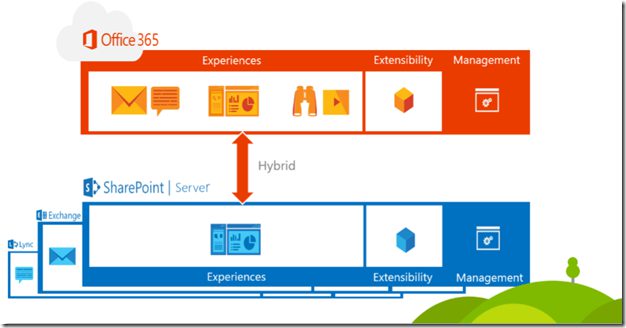The Evolution of SharePoint Server 2016
In case you missed it, Julia White, general manager of the Office Product Management team at Microsoft, shared an update this morning on the Office blog site that touches on the maturing of the SharePoint platform, and a little bit of what we can expect at Ignite in May. For those looking for specifics on what will be included in the vNext of SharePoint on prem….sorry to disappoint you, but you’ll need to wait for the preview or Ignite to learn more. What Julia does cover, however, is the change in focus and in the language used to define how Microsoft will continue to add to this platform.
You’ve heard various Microsoft people using the term "experiences" over the past year to describe some of what they are working on. Think of "experiences" as replacing the much disliked "SharePoint wheel." An experience does not necessarily equal a feature, or even a product SKU, but is an abstracted definition of a defined end user experience. An experience might span multiple workloads, such as the new Groups experience that moves across email, calendar, file share (OneDrive), and social (Yammer) workloads. Similarly, experiences may span online and on prem infrastructures, as well.
Think of experiences as the presentation layer of your collaboration stack, with management and extensibility layers. The diagram Julia shared helps a bit to convey this messaging:
I recommend you read through Julia’s post to get a sense of Microsoft’s positioning on the run up to Ignite, but here are my primary takeaways — some that I came up with from this post, some that I have been thinking about the past few months in my conversations with the product team and members of the community:
- SharePoint Server 2016 will be the most challenging release in the platform’s history. As I’ve written about in the past, the forthcoming SharePoint on prem release has been one of the most difficult and complex releases in SharePoint’s 15+ year history. It’s not just a matter of branching off of the Office 365 code and packing for on prem distribution. Many of the new O365 features were designed for the cloud. As such, Microsoft has had to make decisions about what makes sense to bring on prem, how these components would work alongside O365 in a hybrid model, and the impact for customers who later move all or part of their knowledge assets to the cloud. In short, this release is as much about what comes with the next version as it is about how Microsoft delivers the release. And then tack onto all of that the messaging and sales collateral, and try to bolster cloud sales while also being supportive of on prem and hybrid customers. That’s huge, folks.
- Hybrid and On-Prem are still going strong. I’ve been one of the most vocal supporters of the hybrid model over the past couple years, and not just because I spent 5 years working as the evangelist for two of the largest ISVs, but because the reality is that not every customer is ready to move to the cloud. In fact, most customers are not ready, and require time to transition OR need options to staying right where they are on premises. Microsoft has done an about-face on their messaging in the past year, taking feedback from customers and the expert community, and developing content and solutions for the hybrid cloud.
- Microsoft thinking more about the management layer. Speaking of hybrid and on-prem solutions, Microsoft has also been listening to their customers about needing stronger management controls of increasingly complex infrastructure. This is one area where I am excited to learn more about at Ignite, as the management experience across workloads (SharePoint, Exchange, OneDrive, Yammer, Lync) has been missing, leaving much of it up to the partner ecosystem. And while there are some powerful tools available through the partners, it just makes sense for some of these capabilities to be a part of the platform itself. We’re seeing bits and pieces of these investments through the releases of Data Loss Prevention (DLP) and Mobile Device Management (MDM) capabilities, but I’m hoping to get more of a comprehensive story in the months to come.
- Microsoft is moving faster around extensibility. While not my wheelhouse, I do monitor what a number of community members and partners are doing around extending the existing experiences. For example, fellow MVP Waldek Mastykarz has done some experimenting with Delve and the Office Graph to helps organizations how they can get the most out of the new capabilities. I expect more of this kind of experimentation in the coming year as Microsoft expands on existing APIs. I remember a couple years back talking with some Microsoft folks about their internal cross-platform and open source development efforts and support, and having them brush it off as an anomaly — to see Microsoft now supporting things like the Patterns and Practices project.
I am excited to participate in this year’s Ignite event in Chicago, and am looking forward to getting into the specifics within each of these areas – especially around the management layer Microsoft is building out. While the marketing messaging may evolve and change, the underlying technology that is SharePoint is becoming more ingrained into how enterprises collaborate. I have always been bullish on the long-term SharePoint story, and I expect be to in the space for quite a few more years, and this year will help us better understand what future support for on prem and hybrid environments will look like. Looking forward to the next step in SharePoint’s evolution!





